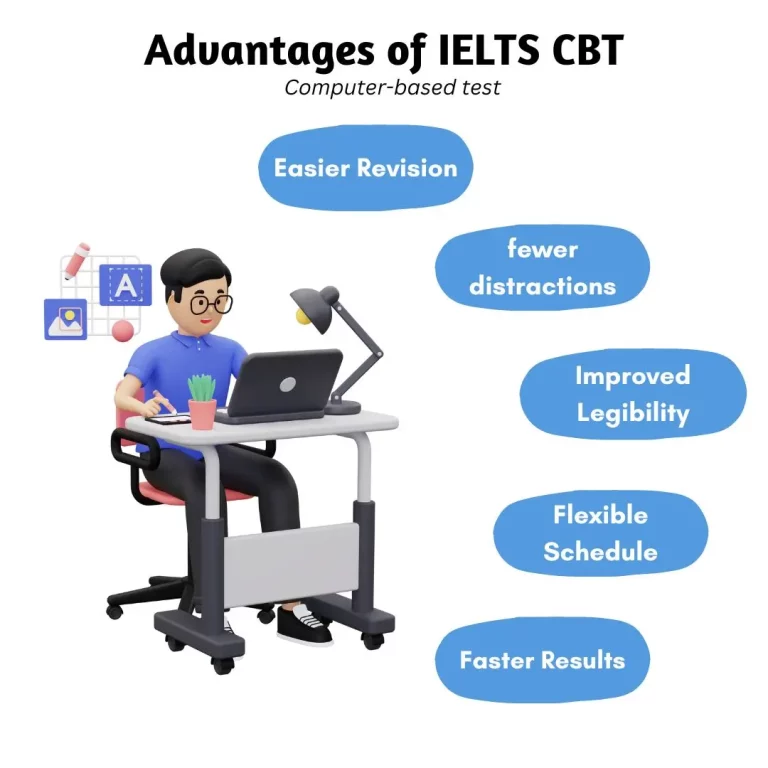Advantages of Computer-Delivered IELTS Over Paper-Based IELTS
Faster Results: Typically, results from the computer-delivered IELTS exam are available within 5-7 days, compared to 13 days for the paper-based exam.
Easier Revision: Changing your answers in the Writing section is much more straightforward on a computer.
Improved Legibility: Typed responses are easier for examiners to read, which could avoid misinterpretation of handwriting.
Flexibility in Scheduling: Computer-delivered tests are often available multiple times a day and throughout the week.
Comfortable Testing Environment: Modern test centres designed for computer-delivered tests often provide a better testing environment with fewer distractions.
Candidates can excel in their computer-delivered IELTS exam by preparing effectively and understanding the format. Whether improving their typing skills or practising with the right materials, these tips and insights into the differences and advantages of the computer-delivered format will help them achieve a high score on their IELTS exam.
IELTS Vs PTE
The International English Language Testing System (IELTS) exam and the Pearson Test of English (PTE) Academic are prominent English language proficiency tests recognised worldwide. However, they cater to different needs and preferences due to their distinct formats and scoring methods. Here’s a detailed comparison of the IELTS exam and the PTE, emphasising their unique features and testing methodologies.
Test Format and Content
The IELTS exam is available in two versions: IELTS Academic and IELTS General Training. Depending on the version, the IELTS exam tests all four language skills: listening, reading, writing, and speaking. The speaking part of the IELTS exam is conducted face-to-face with an examiner, which is a distinctive feature of the IELTS exam as it aims to simulate a real-life conversation. The total test time for the IELTS exam is about 2 hours and 45 minutes.
In contrast, the PTE Academic also assesses listening, reading, writing, and speaking skills but integrates these into a computer-based test that lasts approximately three hours. The PTE’s speaking test involves speaking in a computerised microphone, which can feel less personal than the IELTS exam’s approach. However, it offers the advantage of analysing speech more consistently through its automated scoring system.
Scoring
Scoring for the IELTS exam is on a band scale from 1 to 9 for each part of the test, with an overall band score calculated as an average of four. This makes the IELTS exam scoring transparent and allows test-takers to clearly understand their proficiency level across different language skills.
The PTE, however, employs a complex algorithm to deliver scores ranging from 10 to 90, representing the ability to use and understand English. The PTE scores each skill and sub-skill, providing a granular view of a candidate’s proficiency, which can be particularly useful for institutions requiring detailed performance data.
Test Availability and Results Turnaround
The IELTS exam is widely available, with test centres in over 140 countries and tests held multiple times a month. However, scheduling can sometimes be less flexible than the PTE because the IELTS exam includes a face-to-face interview.
On the other hand, the PTE offers more flexibility in scheduling, with test dates available at numerous centres worldwide nearly every day. Results from the PTE are typically available within five business days, faster than the IELTS exam, where results are released 13 days post-test for the paper-based version and 5 to 7 days for the computer-delivered version.
Acceptance and Recognition
The IELTS exam and the PTE are widely recognised by universities, employers, and government bodies worldwide. However, the IELTS exam is often preferred in the UK, Australia, and Canada for immigration purposes, reflecting its longstanding history and established trust in these regions. The PTE is gaining recognition rapidly and is widely accepted by universities, especially in Australia and the USA, thanks to its modern, computer-based testing format and quick result turnaround.
Choosing between the IELTS exam and the PTE largely depends on personal preference and the specific requirements of the institutions to which one applies. The IELTS exam might be more suitable if you prefer a more traditional test setting and face-to-face interaction. Conversely, the PTE might be better if you are comfortable with computers and require faster results. Ultimately, both tests are designed to assess English language proficiency rigorously and are structured to provide a comprehensive evaluation of language skills.
 IELTS in Dehradun
IELTS in Dehradun

